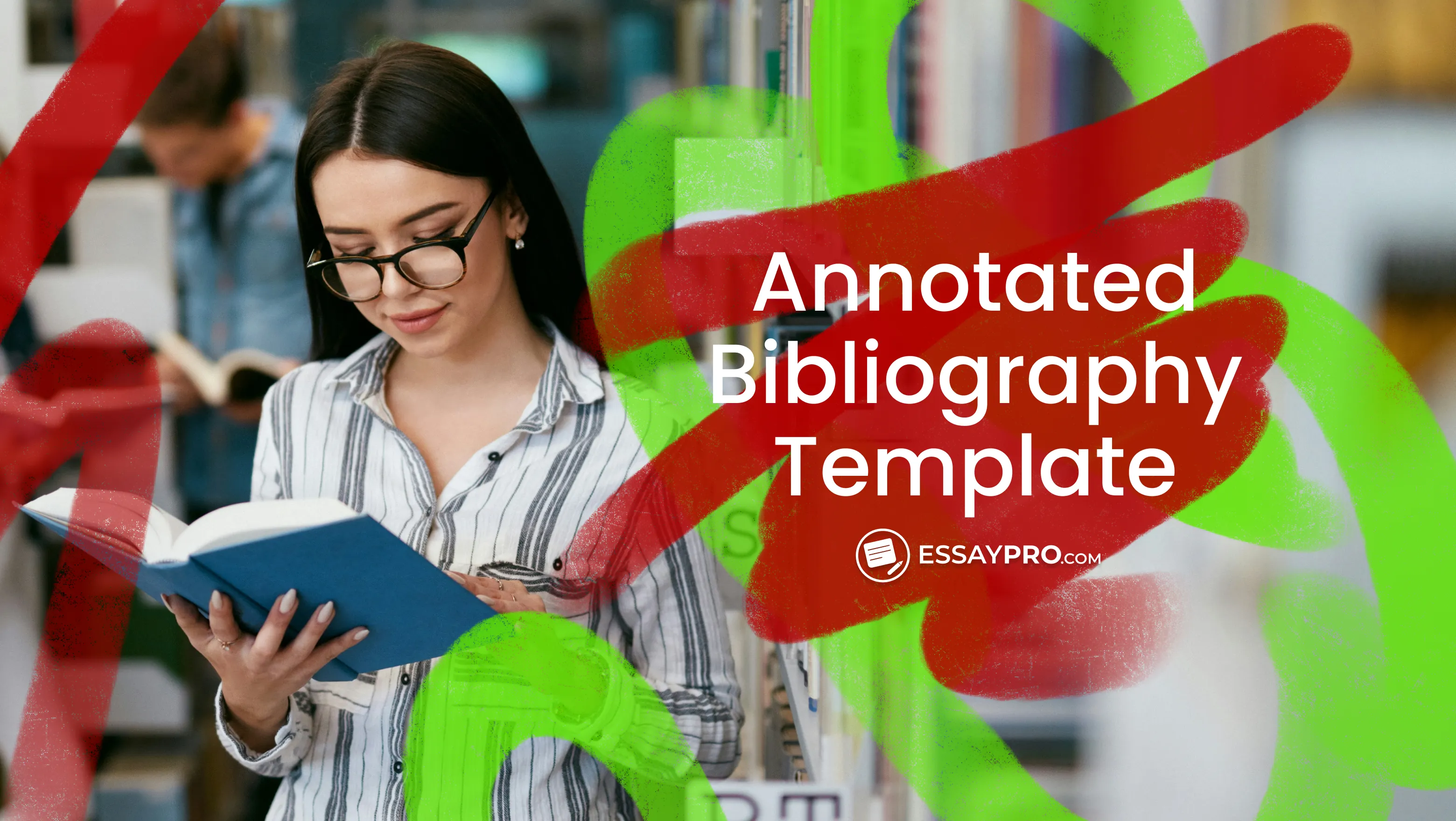An annotated bibliography is a record of sources paired with short notes that evaluate the sources' relevance to your research papers. It's proof that you can actually tell which pieces of the material fit where. In a template for annotated bibliography, you place the citation first, followed by a compact summarization and evaluation of the source.
A clear outline makes building a bibliography far less overwhelming. EssayPro can also support you at this stage. Plenty of students even type 'write my annotated bibliography' when they hit a wall, because they know our writers can step in and help.


General Structure of an Annotated Bibliography Template
An annotated bibliography template follows a pattern that looks simple on paper. Yet, it carries weight. With a clear framework, you can be sure that each entry is organized rather than thrown together. The overall flow rarely shifts, even though different citation styles change the format slightly.
Here’s the basic outline most templates follow:
- Full citation first, formatted in the required style
- Short summary that describes the source’s central ideas
- Evaluation that touches on the source’s accuracy and relevance
- Note on how the source ties into your research process and goals
This approach saves you a lot of time. Once the framework is in place, your effort goes into writing annotations that reveal how valuable each source is.
APA Annotated Bibliography Template
APA style asks for precision and clean organization. An annotated bibliography entry starts with a full reference list written in the standard APA publication manual:
- Author's name
- Year of publication
- Publication details
Then the annotation itself follows that usually ranges from 100 to 200 words. The scientific style of writing asks you to give a brief yet clear summary of the work. This section talks about the sources' reliability and relevance.
The structure stays the same across all entries. You should write in a professional tone, but not so much that the text stops showing your critical thought process. Entry in an APA paper should look like this:
- Full citation in APA format:
- Double-spaced throughout the page
- Hanging indent for each citation (½ inch)
- Annotation starts on a new line beneath the citation
- A summary of the source’s argument or findings
- Evaluation of the source’s authority, accuracy, and timeliness
- Reflection on how it supports your research
Check out our list of the best books for college students. But while we’re still on the topic of bibliographies, here’s a sample of one in APA format:
MLA Annotated Bibliography Template
Authorship carries even more importance in the humanities, where the MLA (Modern Language Association) style is most often used. Each entry in this format starts with a full citation:
- Author
- Title
- Publisher
- Publication date
Instructors often want more description here than they would ask for on the 'works cited' page; they expect critical comments on the author’s perspective or the work’s potential gaps. The entire annotation, according to the MLA handbook, is somewhere around 150 words. It proves you understand both what the source says and what it means for the bigger picture. An MLA-style entry usually includes:
- Full citation in MLA format:
- Double-spaced with no extra spacing between entries
- Hanging indent for each citation (½ inch)
- Annotation follows directly after the citation in the same format
- Summary of main points or themes
- Evaluation of the source’s credibility and weaknesses
- Explanation of how it connects to your thesis
Take a look at an annotated bibliography example in MLA format:
Chicago Style Annotated Bibliography Template
Chicago style leaves more room for variation. That's why it's often preferred in history and social sciences. The entry begins with a citation in Chicago format. Depending on the assignment, it could be:
- Notes and Bibliography style
- The Author-Date style
After that comes the annotation paragraph of about 150 words. It gives the reader a short summary of the source. You start by briefly mentioning the thesis and then start the evaluation. Along the way, you note the quality of the evidence or the author’s perspective. Some instructors ask for annotations that lean heavily on critique, while others want more neutral summaries. The template works for either. A Chicago-style entry typically includes:
- Full citation in Chicago style:
- Two spaces with one-inch margins
- Hanging indent applied to citations (½ inch)
- Annotation begins on a new line beneath the citation
- Summary of central arguments or findings
- Evaluation of the source’s authority and scholarly impact
- Reflection on how it supports your research
If you're writing a research paper for a STEM project, you might have to use a different formatting style - IEEE. Ask a writer from EssayPro, 'Do my physics homework.'
Here’s the final template for an annotated bibliography in Chicago style.
How to Put an Annotated Bibliography Template to Work
An annotated bibliography template allows you to put the formatting headaches aside and write notes that will help your own research project. The steps below will show you how to make your template efficient and genuinely useful.
- Pick Your Style Guide - Start by deciding whether your assignment calls for APA, MLA, or Chicago. Each style has its own set of rules you derail from mid-paper.
- Format the Citation First - Put the citation at the very top. This will save you from rechecking the basics when you should be writing.
- Summarize the Source - Describe the author's points in a few brief sentences. The summary annotations must be factual and easy to scan.
- Evaluate Authority and Usefulness - Ask yourself whether the author presents strong evidence and if the content is still relevant.
- State the Connection to Your Research - Tell the reader why these sources matter for your research project.
- State the Connection to Your Research - Close the entry by telling the reader why these sources matter for your project.
Don’t miss out on these best universities in Japan.
The Final Move
An annotated bibliography template gives you structure. You no longer have to rethink the layout for sources. Instead, you can put your energy into the parts that matter more: summarizing, evaluating, and connecting the sources back to your own research.
If the entire process still feels heavy after reading this guide, or if the instructions have left you second-guessing, you can always rely on EssayPro. A detailed template along with reliable guidance can help you make sure your work meets all the academic standards.
FAQ
Why Should You Use An Annotated Bibliography Template?
The purpose of a template is to give your annotated bibliography more clarity. It tells you how to format your citations and how to arrange the annotated list. A template can save you time and help present your work in a more professional way.
Can One Template Work For Different Citation Styles?
One template can't cover different citation styles because each has its own set of rules. The best approach is to use a template designed for the specific style you need.
How Can You Tell Which Style Template To Use?
Look at the assignment guidelines first because professors usually specify the required style. If it isn’t mentioned, ask for clarification before you start.

Ana Ratishvili
Ana is a professional literary writer with a Master’s Degree in English literature. Through critical analysis and an understanding of storytelling techniques, she can craft insightful guides on how to write literary analysis essays and their structures so students can improve their writing skills.
- Library Study Smart. (2017). https://www.westernsydney.edu.au/__data/assets/pdf_file/0017/1340450/Annotated_bibliography.pdf
- Guides: Referencing and citing: Annotated bibliographies. (2025). https://libguides.victoria.ac.nz/referencing-citing/annotated-bibliographies
- Poliness, S. (n.d.). Library Guides: Annotated Bibliography: Examples of annotated sources. https://libraryguides.vu.edu.au/c.php?g=923042&p=6672342





.png)
.webp)

